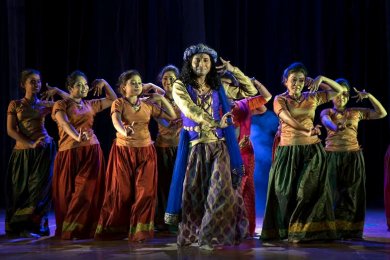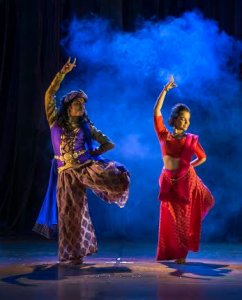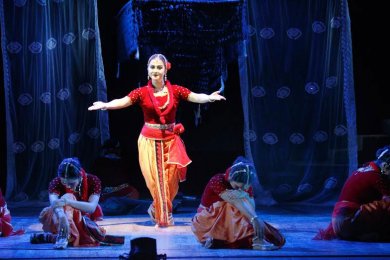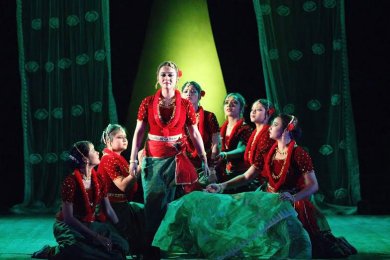
|   |

|   |
Arnab Bandopadhyay's Yugaant and Bimbavati Devi's Devatmayee - Tapati Chowdurie e-mail: tapatichow@yahoo.co.in October 20, 2014 Arnab Bandopadhyay has made quite a name with his creative choreographies. In his dance theatre productions he uses more than one dance form. Known as an Odissi dancer of Kelucharan style of dance, he used Bharatanatyam, Chhau and martial art forms in his latest production Yugaant. In Yugaant, the content was from the great epic Mahabharata, the interpretation was contemporary and the technique used was dance theatre using more than one classical dance form. India is so rich in its classical and folk dance forms that an innovative mind can work wonders with them. The anxiety of the epic Kurukshetra war was translated into the anxiety felt by modern man. The Shastras very clearly state that human emotions remain the same from the beginning of time. Therefore, the feelings evoked at the great war of Mahabharata would be the same today when faced with a similar situation evoking anxiety and fear. In the first scene of the story Krishna and Gandhari were in the scene of battle filled with the dead bodies of the victorious and the vanquished. When the stage lights were on and they were inspecting the bodies, the bodies transformed into furious human installations reflecting contemporary anxiety. Both the epic characters bear resemblances to contemporary characters. The powerful choreography compared the battle field to another anxious battle field of our times in the furious and agitated activities of a busy corporate office, with the employees thumping away on computer keys and speaking over cell phones in a mad rush to complete a lot in too short a time to meet up targets. A successful parallel had been drawn. People vying with each constantly making and changing strategies to outdo the opponent.   Yugaant Strategies were made by Dronacharya, who was on the side of the Kauravas to entrap Yudhistira, with his clever Chakravyuha formation - a war formation - the entry and exit of which was only known to Arjuna as narrated to Subhadra when they were together. The anxiety felt by Subhadra was transferred to the baby in her womb, who learns to enter the Chakravyuha. The next scene was the strategy laid by the wily Shakuni who invited the Pandavas in a game of dice, where what seemed fair was foul. It was a political strategy and motivated to overthrow the Pandavas. To digress from the content, the scene was unusual in its depiction, because group dancers were used to show the game in process, the abhinaya of the Kauravas and the Pandavas were telling. Having lost in the game the Pandavas were required to spend their years of exile and round it off with a year in hiding. It is a question of strategies all through. Arjuna disguised as Brihannala was training Uttara, when her brother Uttar announced the attack of his Matsya kingdom by some unknown forces. Pandavas were in the fag end of their disguise. Arjuna gave his true identity and was willing to be the charioteer to overthrow the invading army, which happened to be those of the Kauravas, who all along had suspected the existence of the Pandavas in the Virat kingdom and had come searching for them under the pretext of stealing cattle. Here the Kauravas were defeated in their strategy. Abhimanyu was introduced to the audience in the company of his newly married wife Uttara, after which he was found in the battle grounds of Kurukshetra, where on the thirteenth day of the battle of Mahabharata he entered the powerful Padmavyuhan - the seven-tier defensive spiral formation - battle formation of the Kaurava army. The entry and exit of this secret technique was known only to Arjuna, Pradyumna and Krishna on the Pandava side. The strategy here was to draw Arjuna in battle on another side of the field, giving him no clue of the impending danger soon to befall. Abhimanyu entered the Chakravyuha but the Pandava army was no match for him. They could not keep pace with Abhimanyu. The Kauravas could not face him on a one to one basis. He could not be vanquished other than by foul means, which the Kauravas resorted to, killing him mercilessly. The audience held their breath. Indian martial art forms were used to show this gruesome battle. The props used were original and creative. Mourning wives and mothers were shown. Very imaginatively the choreographer used muppets resembling political leaders, corporate czars instilling fake empathy amongst the crowd to reinstate their hold on society and the helplessness of the common man, their pawns and puppets in their strategic games. Subhadra who was in the battle field with brother Krishna thought about the plight of human beings. Soon after followed the enactment of a political murder of a corporate executive which faded into agony and anguish, closely connected with genocide and mass pogrom (violent riots) of our world of which the human kind are the inheritors. The pattern was identical if not similar with the world of our epic. Arnab made a statement that needs reflecting upon, but can a solution be found? The concept, choreography and creative direction was by Arnab Bandopadhyay. The dancers Sanjukta Ray, Monideepa Seal, Anushka Naskar, Anwita Chanda, Sreeparma Midde, Sourabhi Ghosh, Soumili Biswas, Ananya Ghosh, Tripti Sett, Sumit Panja, Dheemaan Bhattacharya, Arnab Chakroborty, Pratap Mondal, Milan Pal, Soumak Bhattacharya, Aman Khan, Arunava Bhattacharya, Kneel Koushik, Biswajit Das, Pramit Chakroborty, Uttiyo Jana and of course Arnab Bandopadhay were all in good shape and practice. There was not a moment’s pause and things happened fast and quick, with constant outburst of energy on stage. 

Empowerment of women was the subject matter of Devatmayee choreographed by Bimbavati Devi of Manipuri Nartanalaya. It had for its theme the changing of a woman from being a mere mortal to a god. A good question that came to this reviewer’s mind was that, why should a woman be a Devi in order to be empowered. Society accepts a man as he is without having him change to a god. It is an obvious observation. Devatmayee, the soul of the gods was Bimbavati’s brain child. A good dancer cum choreographer (dance is in her blood) Bimba added colour and beauty to the whole show. The 40th anniversary of Manipuri Nartanalaya was celebrated with great pomp and show. Devatmayee was specially planned and enacted with Ratan Thiyam as its chief guest. For the success of a dance drama, good music is a must. In Devatmayee traditional Manipuri ethnic music and Manipuri Nata Sankirtana’s music had been blended with Hindustani vocal music as well as Sanskrit chants. The music emanating from the Manipuri pena transported this reviewer to a world of aesthetic beauty. The music was composed by N.Tikenjit Singh, who is an eminent music director of Manipur. Sanskrit chants and Hindustani vocals were by Srijan Chatterjee, Pena Ishei by K. Subhash Chandra Singh and H. Herojit Singh. H. Nisheshwar Singh and H. Bhagat Singh on violin, R.K. Upendra Singh on rhythm, Prithviraj Singh on the flute, A. Shashi Kumar Sharma on sarod, Gayatri Devi, Pintu Devi, Roma Devi and Geeta Rani Devi on vocal, Meina Singh on percussion and special effects by N. Tiken Singh comprised the excellent music ensemble and greatly enhanced the aesthetic value of the presentation. Scripted by Srijan Chatterjee, Devatmayee is the ancient Vedic perception of the mother goddess portrayed in the Manipuri way. Here the Vedic interpretation has been contrasted and compared with Meitei concepts. The Mother Goddess is tranquil, radiant with the power of endurance. She is an epitome of splendor. She is time and hence brings about devastation. She is our words - both spoken and unspoken. Her qualities make her divine. Devatmayee was all about a woman’s journey of self-realization. The qualities of The Mother Goddess are to be emulated by her to elevate her. She has to be tranquil like Ratri and radiant like Usha, endure like Prithvi, shine like Kamala and Annapurna in her splendor and abundance. She has to be knowledgeable of passing time - Kali stands for time - and how time is the greatest destroyer. Our expressed and unexpressed word is vaak. Clarity of vision, good dancing and imaginative stage props made the presentation magnificent. Appropriate costumes with swift changes gave the play its necessary appeal. Besides classical Manipuri style, the choreographer has used folk forms, wherever needed. Movements of Thang Ta has been modified and used. The dancers of Manipuri Nartanalaya who took part were Tanusree Das, Arpita Saha, Mousumi Banerjee, Ivana Sarkar, Kankana Singh, Noel Datta, Piyas Mondal, Anupama Devi, Asharani Devi, Warda Rihab, Sweety Das, Manomi Tanjana Orthy, Hena Singha, Rintu Das, Biplab Ghosh, Mousumi Nandi, Subhadip Sarkar, S. Tombi Singh and the choreographer Bimbavati Devi. The audience stayed glued to the show till the end. Tapati Chowdurie learnt dance for almost 10 years from Guru Gopinath in his dance institution Natana Niketan in Madras. For a brief period, she was with International Centre for Kathakali in New Delhi. Tapati has a Master's degree in English Literature and Bachelor's degree in Education. She has a regular column in The Statesman, where she writes on dance and music. She also writes for The Hindu and Sruti. Presently, she is a freelance writer. |